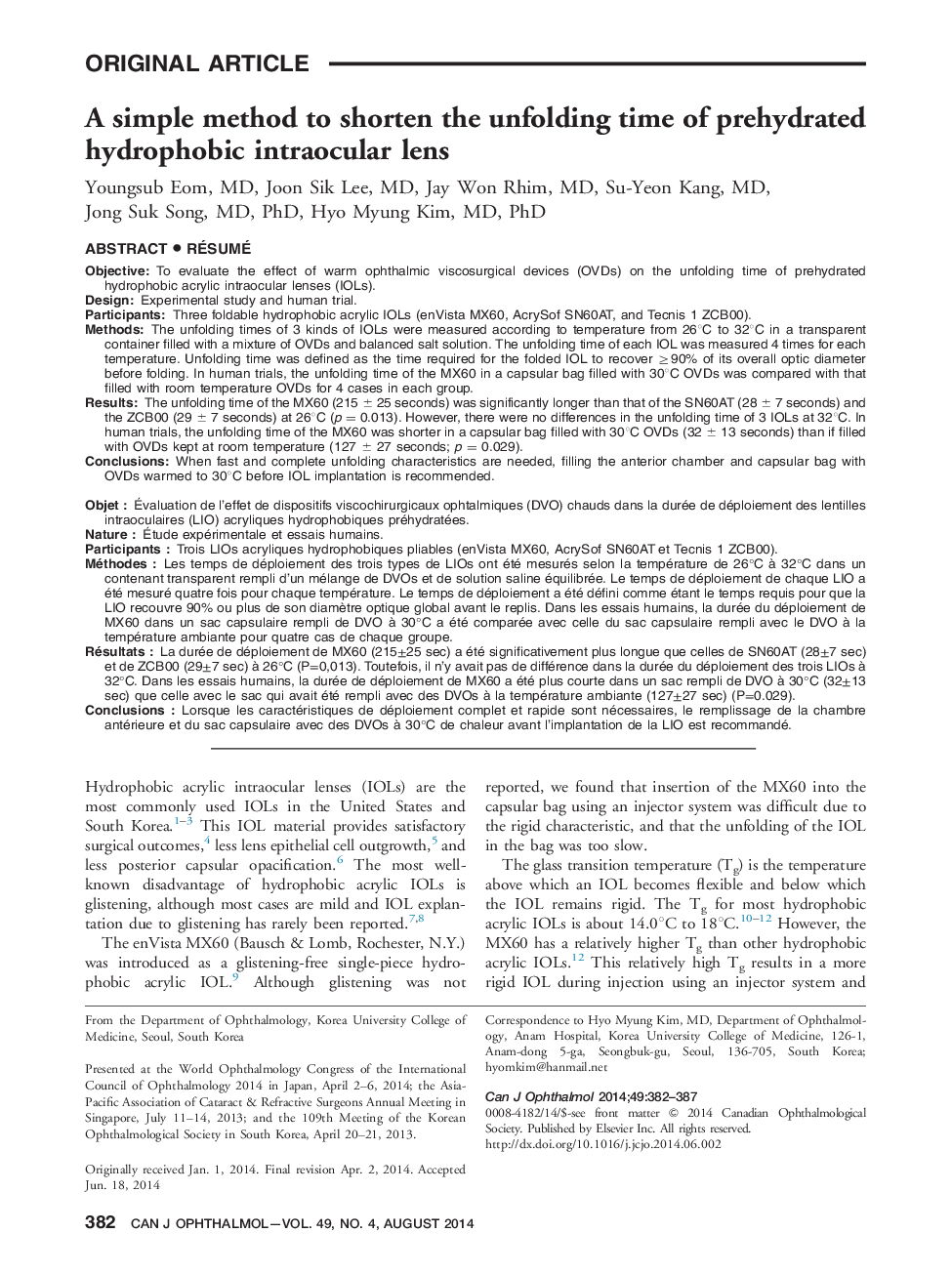| کد مقاله | کد نشریه | سال انتشار | مقاله انگلیسی | نسخه تمام متن |
|---|---|---|---|---|
| 4009326 | 1602402 | 2014 | 6 صفحه PDF | دانلود رایگان |
ObjectiveTo evaluate the effect of warm ophthalmic viscosurgical devices (OVDs) on the unfolding time of prehydrated hydrophobic acrylic intraocular lenses (IOLs).DesignExperimental study and human trial.ParticipantsThree foldable hydrophobic acrylic IOLs (enVista MX60, AcrySof SN60AT, and Tecnis 1 ZCB00).MethodsThe unfolding times of 3 kinds of IOLs were measured according to temperature from 26°C to 32°C in a transparent container filled with a mixture of OVDs and balanced salt solution. The unfolding time of each IOL was measured 4 times for each temperature. Unfolding time was defined as the time required for the folded IOL to recover ≥90% of its overall optic diameter before folding. In human trials, the unfolding time of the MX60 in a capsular bag filled with 30°C OVDs was compared with that filled with room temperature OVDs for 4 cases in each group.ResultsThe unfolding time of the MX60 (215 ± 25 seconds) was significantly longer than that of the SN60AT (28 ± 7 seconds) and the ZCB00 (29 ± 7 seconds) at 26°C (p = 0.013). However, there were no differences in the unfolding time of 3 IOLs at 32°C. In human trials, the unfolding time of the MX60 was shorter in a capsular bag filled with 30°C OVDs (32 ± 13 seconds) than if filled with OVDs kept at room temperature (127 ± 27 seconds; p = 0.029).ConclusionsWhen fast and complete unfolding characteristics are needed, filling the anterior chamber and capsular bag with OVDs warmed to 30°C before IOL implantation is recommended.
RésuméObjetÉvaluation de l’effet de dispositifs viscochirurgicaux ophtalmiques (DVO) chauds dans la durée de déploiement des lentilles intraoculaires (LIO) acryliques hydrophobiques préhydratées.NatureÉtude expérimentale et essais humains.ParticipantsTrois LIOs acryliques hydrophobiques pliables (enVista MX60, AcrySof SN60AT et Tecnis 1 ZCB00).MéthodesLes temps de déploiement des trois types de LIOs ont été mesurés selon la température de 26°C à 32°C dans un contenant transparent rempli d’un mélange de DVOs et de solution saline équilibrée. Le temps de déploiement de chaque LIO a été mesuré quatre fois pour chaque température. Le temps de déploiement a été défini comme étant le temps requis pour que la LIO recouvre 90% ou plus de son diamètre optique global avant le replis. Dans les essais humains, la durée du déploiement de MX60 dans un sac capsulaire rempli de DVO à 30°C a été comparée avec celle du sac capsulaire rempli avec le DVO à la température ambiante pour quatre cas de chaque groupe.RésultatsLa durée de déploiement de MX60 (215±25 sec) a été significativement plus longue que celles de SN60AT (28±7 sec) et de ZCB00 (29±7 sec) à 26°C (P=0,013). Toutefois, il n’y avait pas de différence dans la durée du déploiement des trois LIOs à 32°C. Dans les essais humains, la durée de déploiement de MX60 a été plus courte dans un sac rempli de DVO à 30°C (32±13 sec) que celle avec le sac qui avait été rempli avec des DVOs à la température ambiante (127±27 sec) (P=0.029).ConclusionsLorsque les caractéristiques de déploiement complet et rapide sont nécessaires, le remplissage de la chambre antérieure et du sac capsulaire avec des DVOs à 30°C de chaleur avant l’implantation de la LIO est recommandé.
Journal: Canadian Journal of Ophthalmology / Journal Canadien d'Ophtalmologie - Volume 49, Issue 4, August 2014, Pages 382–387
